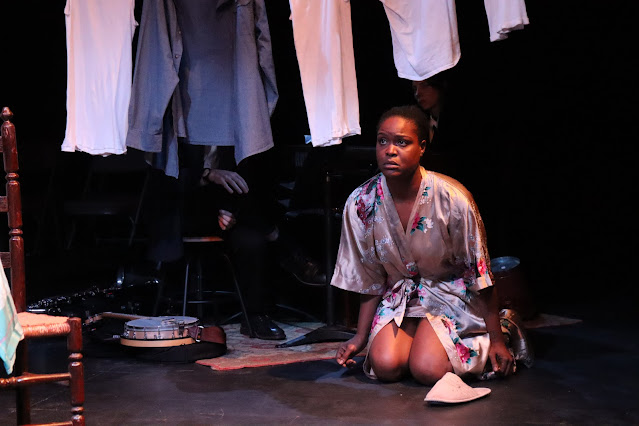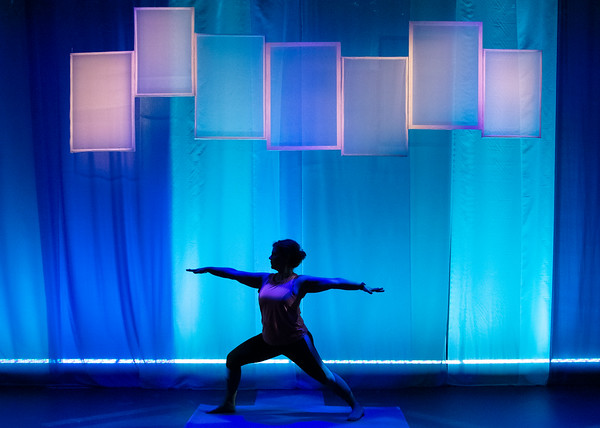Review: "Fandango for Butterflies (and Coyotes)" Raises Undocumented Voices
Fandango for Butterflies (and Coyotes)
Written by Andrea Thome
Directed by José Zayas
Music by Sinuhé Padilla
Presented by En Garde Arts at La MaMa Experimental Theatre Club
66 E 4th St., Manhattan, NYC
February 6-15, 2020
 |
| Roberto Tolentino (center) with the company. Photo by Maria Baranova |
February 19-20
In Association with LaGuardia Performing Arts Center
LaGuardia Performing Arts Center (31-10 Thomson Ave, Long Island City, Queens)
February 28
Snug Harbor Cultural Center and Botanic Garden (1000 Richmond Terrace, Staten Island)
March 12
In Partnership with Lehman Stages
Lehman Stages (250 Bedford Park Blvd W, Bronx)
March 20-21
In Association with Open Hydrant at The Point
The Point (940 Garrison Ave, Bronx)
March 26-March 28
In Association with Irondale Ensemble Project
Irondale Center (85 S Oxford St, Brooklyn)
In some instances, the term fandango refers not only to the triple-meter musical form but to a community party at which guests dance, play, and sing. It is this more expansive—one might say inclusive—definition features in the new play Fandango for Butterflies (and Coyotes), making its world premiere at La MaMa in Manhattan before touring the remaining boroughs of New York City. Featuring original music by Sinuhé Padilla, the show interlaces song and dance with a narrative inspired by interviews conducted by playwright Andrea Thome with undocumented immigrants from Latin America. Grounded in the values of empathy, community, and resistance to oppression and dehumanization, Fandango for Butterflies (and Coyotes) feelingly expresses both the joy and heartache that infuse its characters' experiences.
 |
| L-R: Carlo Albán, Sinuhé Padilla, Andrés Quintero. Photo by Maria Baranova |
The hypocritical realities behind who gets snatched up by the government are pointed to by Rogelio and Elvin's acknowledgment that they would essentially be safe were they to work with horses at the lucrative racetracks rather than, as they do, on a private ranch. In line with how the government targets and demonizes undocumented laborers but not their employers, "enforcement" generally stops short of truly interfering with established methods of maximizing profit through capitalist exploitation. At another point, Elvin says that he came to the United States with just his underwear, the kind of story that the current administration is reprehensibly attempting to stamp out even for documented immigrants, with its new "public charge" restrictions on green cards and other visas. Fandango for Butterflies (and Coyotes) explores far more than the economics of its characters lives, however. The title itself refers not only to Mariposa's namesake but also to a figurative throughline: butterflies, as Mari says, may be fragile but can "go so far," while their caterpillar forms evoke becoming and transformation. Johan describes being seen, a word that takes on multiple resonances, as something scary but thrilling, and Rogelio, who loves poetry, wonders if others can truly know him in an adopted language that he hasn’t fully mastered. Rafaela and Pili bond over strict female relatives and restrictive gender roles, and Elvin enumerates the ways in which being monitored ceaselessly impacts almost every aspect of his life. Late in the play, the staging becomes more impressionistic, a tapestry of the difficulties, fears, guilt, expense, and resilience involved in coming to the United States, as well as a reminder that not everyone crosses the desert—some arrive buckled into an airline seat—but everyone leaves or is left behind by loved ones, and an equally important reminder of the vital need—for everyone, including allies—to protest and resist attacks on those, documented or undocumented, who travel to the United States. And throughout it all, we also see how cultural traditions themselves travel and transmute.
 |
| L-R: Carlo Albán, Jen Anaya, Sinuhé Padilla, Silvia Dionicio. Photo by Maria Baranova |
 |
| L-R: Carlo Albán, Silvia Dionicio. Photo by Maria Baranova |
Fandango for Butterflies (and Coyotes) is a production that reaches beyond the stage, and not only in its subject matter. Audience members are invited to join the fandango after the show proper ends and are even invited to bring their own jaranas for that purpose. Outside the house doors is a table with handouts, such as what to do if ICE has detained a loved one. And the program includes a link to the GoFundMe started by Pilar Perez, who inspired the character of Pili, for legal fees for her sister, who is currently living in a shelter with her two small children after escaping a domestic violence situation and is facing an order of deportation.
To paraphrase Pili, what happens to one, happens to all. Mari describes the fandango as a circle, made in opposition to fear, that welcomes everyone. Both poignant and joyful, Fandango for Butterflies (and Coyotes) functions much the same.
-John R. Ziegler and Leah Richards



Comments
Post a Comment